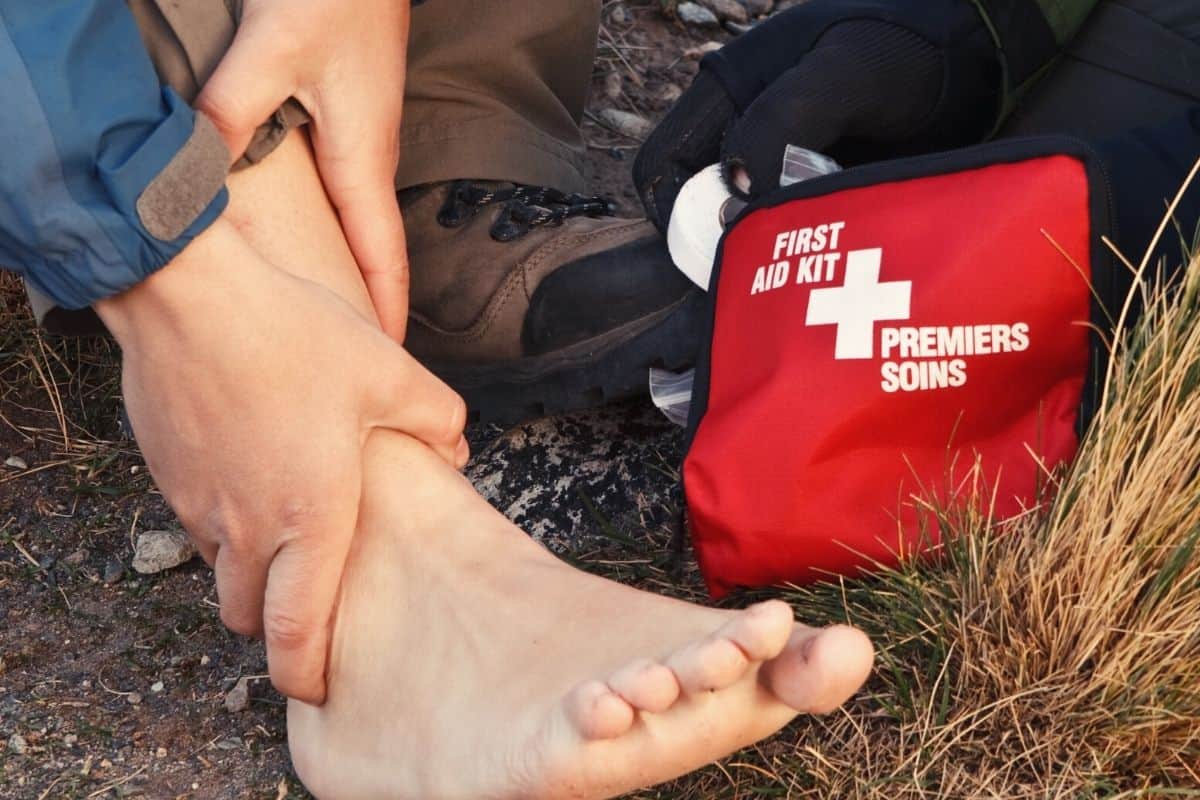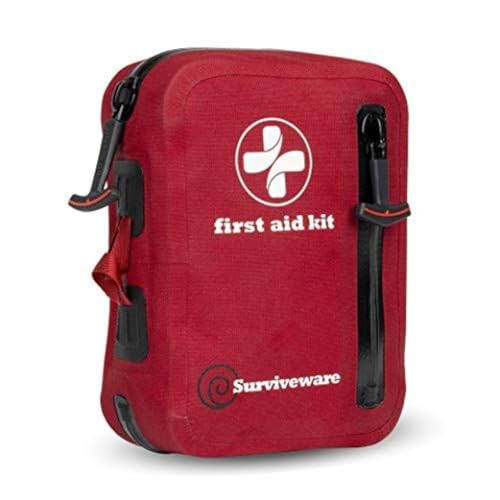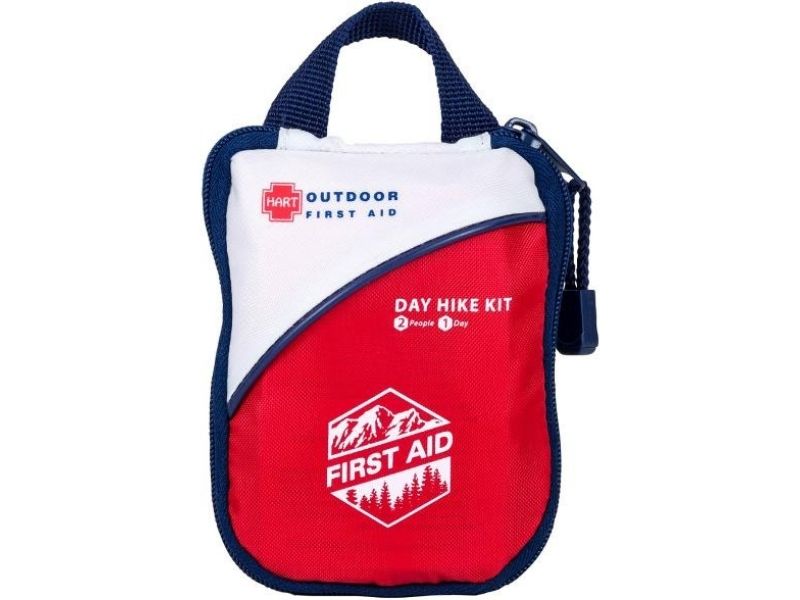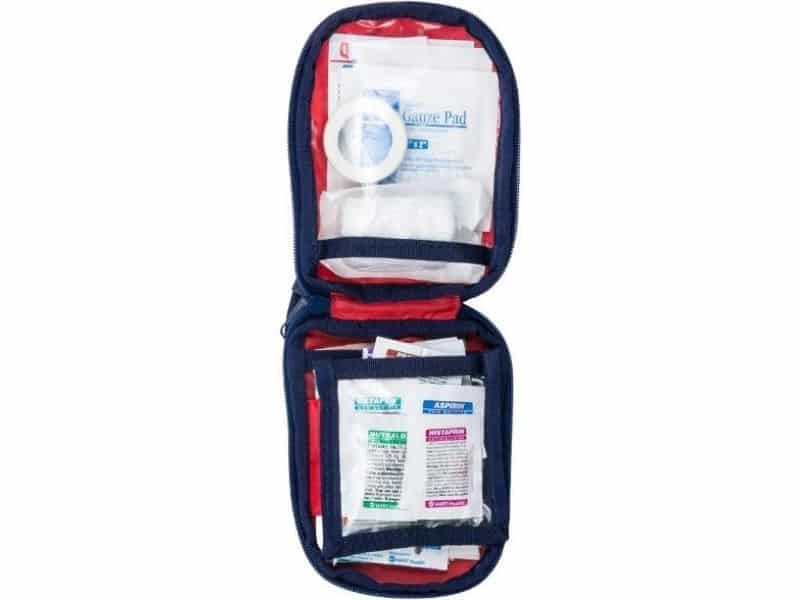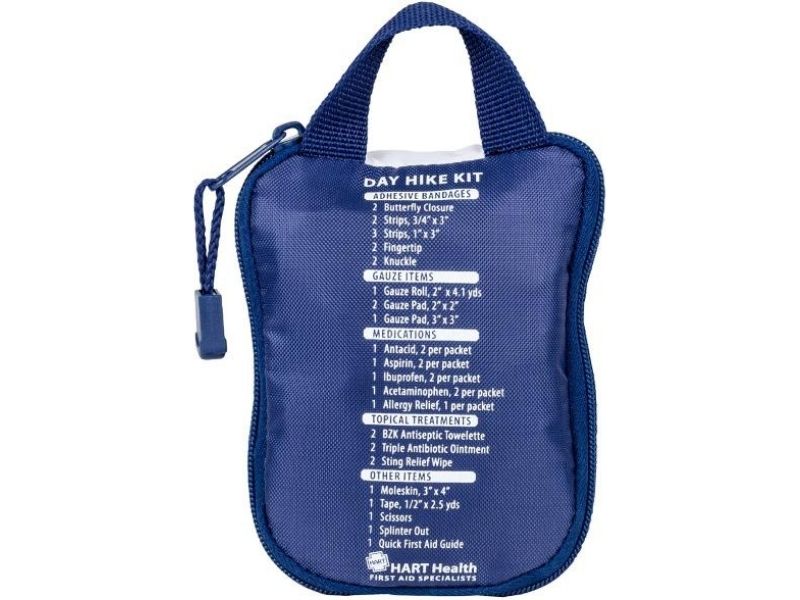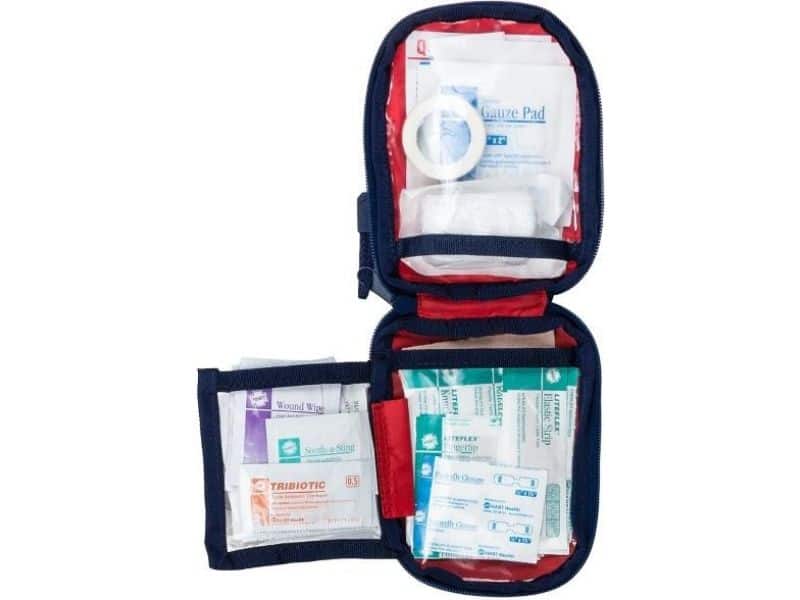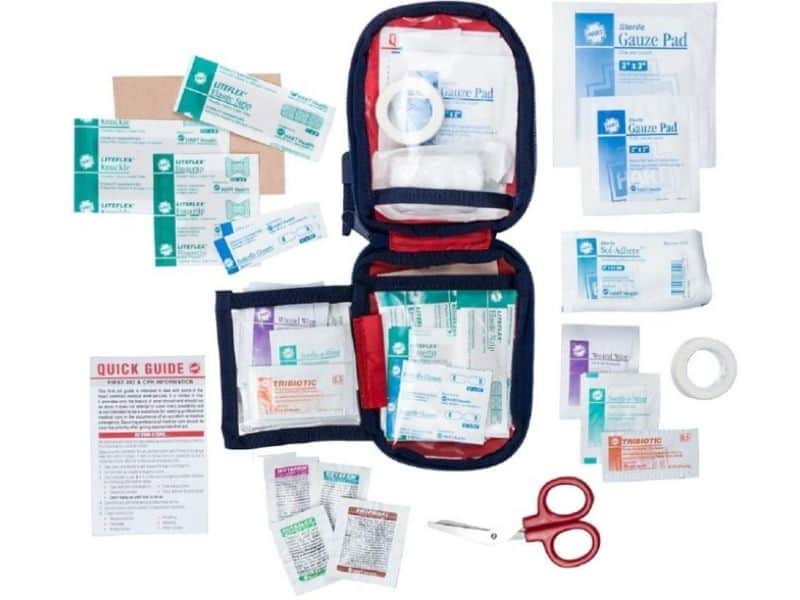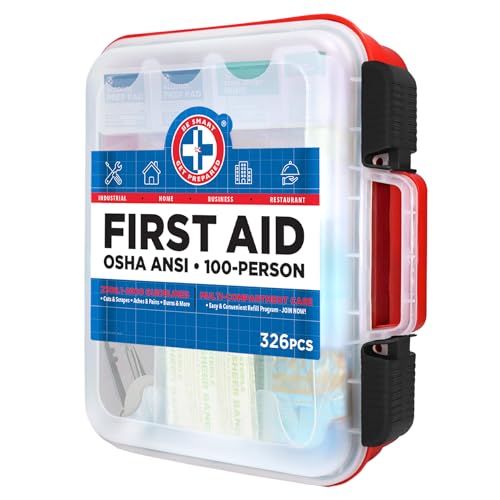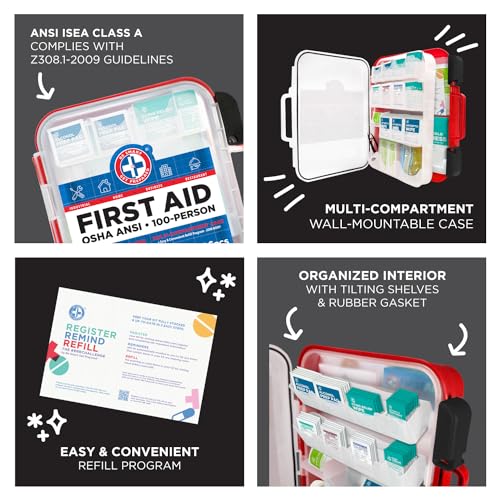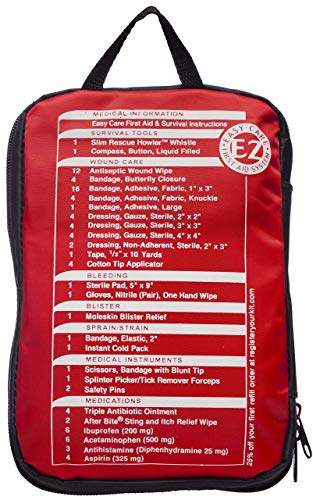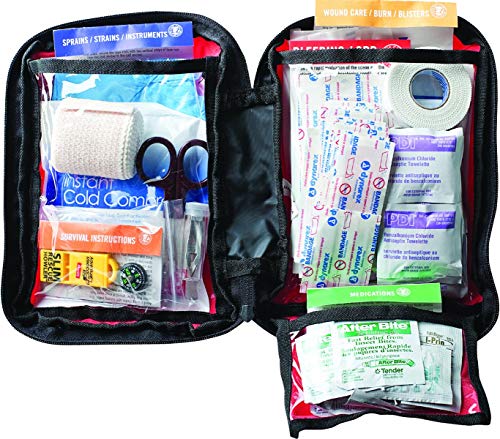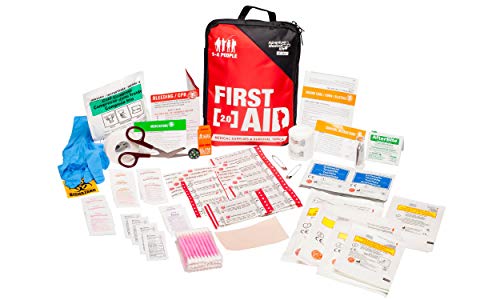When traveling out in the backcountry, one of the ten essentials you should carry at all times is a good first aid kit.
Whether you’re traversing easy trails or out on challenging multi-day hikes in rougher terrain, the number of ways you can do yourself harm is vast. Blisters, chafing, cuts, scrapes, broken bones, allergic reactions, insect bites, sprains, and bruises are a mere few of the injuries or ailments that might befall you on the trail…
…and can be treated easily if you have a well-stocked backpacking first aid kit along for the trip.
We’ve put together a list of the 11 top kits for hiking and backpacking to help you find the ideal option for your needs. Our list includes kits for every group size and trip duration and caters to every budget.
Whether you need a great first aid kit for day hikes, thru-hikes, or weekend camping trips, the Adventure Medical Kits Ultralight Watertight 7 is our ultimate top pick.
Below are our recommendations, along with advice on how to pick your kit for hiking and backpacking, and how to treat common hiking ailments and injuries.
Table of Contents
- What are the best first aid kit for camping, hiking and backpacking?
- Adventure Medical Kits Ultralight Watertight 7
- Surviveware Small First Aid Kit
- HART Outdoor Day Hike
- Adventure Medical Kits Mountain Backpacker
- First Aid Only Outdoor Kit
- I Go First Aid Kit
- Be Smart Get Prepared 326-Piece
- My Medic MyFak
- Ready America 72-Hour Emergency Kit
- VSSL First Aid Mini
- Adventure Medical Kits Adventure 2.0
- How to choose a Good first aid kit?
- What are Common Backpacking and Hiking Ailments and Injuries?
- Best Hiking & Backpacking First Aid Kits: The Verdict
At a Glance: Quick Recommendations
-
Editor’s Choice:
Adventure Medical Kits Ultralight Watertight 7
“Comprehensive, high-quality supplies in a lightweight, waterproof package.” -
Best for Day Hikes:
Surviveware Small First Aid Kit
“A basic first aid kit that has everything you need for weekend trips or group day-hikes.” -
Best Personal:
HART Outdoor Day Hike
“Ultralight, compact, and adequately stocked for solo day hikes or weekend excursions.” -
Best for Group Hikes:
Adventure Medical Kits Mountain Backpacker
“A comprehensive assortment of all necessary items for groups of 4-6 for multi-day trips.” -
Best Value:
First Aid Only Outdoor Kit
“A soft-sided, zippered case with a good selection of supplies for the price.” -
Best Budget:
I Go First Aid
“This compact, lightweight, simple first aid kit is a great choice for solo hikers or hiking couples.” -
Best for Car Camping:
Be Smart Get Prepared 326 Piece
“The ideal pick for camping families.” -
Best for Basecamping and Expeditions:
My Medic MyFak
“A premium option filled with high-quality items.” -
Best Survival Kit:
Ready America 72-Hour Emergency Kit
“This “bug out” bag is ideal for emergency situations but also great for car camping or cabin stays in the wild.” -
Best Premium:
VSSL First Aid Mini
“The VSSL is completely unique and the most-organized option on our list.” -
Honorable Mention:
Adventure Medical Kits Adventure 2.0
“A streamlined version of the AMK Mountain Backpacker.”
What are the best first aid kit for camping, hiking and backpacking?
Our team has carried many different first aid kits over the years, and have shortlisted the following 11 first aid kits below.
- Adventure Medical Kits Ultralight Watertight 7
- Surviveware Small First Aid Kit
- HART Outdoor Day Hike
- Adventure Medical Kits Mountain Backpacker
- First Aid Only Outdoor Kit
- I Go First Aid Kit
- Be Smart Get Prepared 326-Piece
- My Medic MyFak
- Ready America 72-Hour Emergency Kit
- VSSL First Aid Mini
- Adventure Medical Kits Adventure 2.0
Adventure Medical Kits Ultralight Watertight 7
Editor’s ChoiceThe Adventure Medical Kits Ultralight Watertight 7 is our pick ast the best overall backpacking first aid kit.
In our pursuit, we sought one with ample high-quality, hiking-specific supplies for 1–4 people for a 3–5-day adventure. We also wanted a trail-worthy carry case and package that wouldn’t weigh us down or take up too much room in our backpack. The AMK ticks all of those boxes.
The AMK is fully waterproof, using siliconized nylon fabric, taped seams, and a water-resistant zipper in the outer bag as well as DryFlex bags to keep each of the items inside dry if you leave the zipper open. So even if you get caught in a downpour or the case accidentally gets submerged, the contents will remain dry and usable.
Inside, you’ll find materials to care for wounds, blisters, burns, and small fractures, including adhesive bandages, tweezers, pre-cut moleskin, gauze, duct tape, alcohol swabs, ointments, and much more.
PROs
- Bright yellow case is easy to locate
- Ultralight
- Comprehensive first aid kit supplies
- Waterproof
CONs
- The pre-cut moleskin is too small for most blisters
Bottom-Line: Lightweight, waterproof, well-stocked, and portable to boot. What more could you ask for? Hands down the best backpacking first aid kit out there.
Surviveware Small First Aid Kit
Best for Day HikesFor day hikes or overnight camping, the Surviveware kit is ideal. It contains over 100 essential first aid items and weighs under a pound. Its compact case fits in a backpack lid or a mesh water-bottle pocket.
The Surviveware case is made with strong, water-resistant polymer material. Inside you’ll find all the essentials for treating cuts, scrapes, burns, and blisters including alcoholic and antiseptic wipes, gauze, bandages, splinter probes, sting relief wipes, and stainless steel scissors.
PROs
- Internal organizer
- Lifetime guarantee
- Waterproof
- Additional space for customization
- Over 100 items
CONs
- Ointments not included
Bottom-Line: A lightweight, compact kit that’s ideal for personal use or day hikes in small groups.
HART Outdoor Day Hike
Best PersonalThe Hart Outdoor Day Hike is a great choice if you are looking for a basic, lightweight kit to throw in your pack in case misfortune strikes on any of your outdoor adventures.
This kit weighs just 3.5 ounces and measures a mere 5.5 x 4.5 x 1 inch, so can easily squeeze into a small interior pocket or the lid of your backpack. Despite this, it contains everything you could need for day hikes with a partner or small group.
This includes everything from medications like antacids, aspirin, ibuprofen, acetaminophen, and allergy relief medicine to wound cleansers, topical relief products, gauze, moleskin, and a wide selection of adhesive bandages.
While not as well-stocked as a medium-sized kit like the Adventure Medical Kits Ultralight Watertight 7, this one’s a little lighter and a better pick for hikers who like everything to be tidy and well-organized.
All in all, the perfect mini-kit for day hikes or trail running!
PROs
- Affordable
- Ideal for day hikes
- Labeled pockets and loops for organization
- Quick Guide gives instructions to treat minor injuries
- Contains medications, wound cleansers, topical relief products, gauze, moleskin, a wide selection of adhesive bandages, and more
- List of first aid kit contents included
CONs
- Not enough supplies for big groups or multi-day trips
Bottom-Line: A basic backcountry first aid kit that’s ideal for solo hikers or hiking couples on day hikes.
Adventure Medical Kits Mountain Backpacker
Best for Group HikesThe Adventure Medical Kits Mountain Backpacker is the perfect choice for group camping or multi-day backpacking excursions.
At 12 ounces, this is a little heavier than the winner of our review, the AMK 7, but contains extra supplies to cater to the (potential) needs of multiple group members. These supplies include bandages, gauze, medical tape, scissors, tweezers, after-bite relief creams, triple antibiotic ointment, and antibacterial pads.
The bag itself isn’t waterproof but is burly enough to keep the contents safe and undamaged, and it has a handle on top to make it easy to carry when not stored in your backpack. Each pocket is also labeled so you can keep the contents organized, which makes it easier to quickly find what you need.
PROs
- Fold-open design
- Lightweight
- Extra space allows you to create a custom kit
- Zippered mesh pockets make it easy to locate items
- Comes with instructions for basic first aid techniques
CONs
- Bag is not waterproof
Bottom-Line: The perfect pick for camping families or backpacking couples.
First Aid Only Outdoor Kit
Best ValueWith 205 pieces of medical kit and tools in total, the First Aid Only Oudoor kit offers great bang for your buck.
The FAOK has a durable nylon case with a fold-open design for added convenience. Inside, a clear plastic liner and multiple pockets help with organization and make it easy to find items.
The assortment of items is impressive given its light weight and relatively low bulk. While not as high quality as the supplies included in pricier kits like the My Medic MyFak or AMK Ultralight 7, it does the job and there’s enough there for group day-hikes or longer trips for individuals or couples.
The kit includes a first aid guide, vinyl gloves, sunblock, blister pads, insect sting relief pads, assorted bandages, gauze dressings, antiseptics creams, ointments for burn relief, and more.
PROs
- Contains 205 items
- Compact
- Soft-sided, zippered case
- Guide included
- Clear pouches make it easy to locate items
CONs
- No supplies to deal with a sprain
Bottom-Line: Ideal for camping, small groups of hikers, or long-distance solo hikes.
I Go First Aid Kit
Best BudgetThe I Go First Aid Kit is a great kit for day hikers who do the occasional overnighter or hike in small groups.
The I Go contains 85 pieces of medical supplies including first aid essentials like gauze pads, varying shapes and sizes of bandages, medical tape, tweezers, and even an ice pack.
What we love most about the I Go, however, is the packaging. All of the above is housed in a hard carry case that keeps all your supplies clean, dry, and easily accessible. It also comes with a bright red exterior pouch that is easy to see in a backpack or inside your tent.
Despite including ample first aid supplies for a group of 4 hikers, the I Go weighs just 12 ounces and takes up very little room in your pack.
PROs
- Lightweight and compact
- Good variety of supplies
- Plenty of space to add more essentials
- Hard case
- Water-resistant
- See-through pouches make it easy to get what you need
CONs
- No pain medication or ointment included
Bottom-Line: This affordable, lightweight kit is more user-friendly than most first aid kits and contains enough supplies for long weekends in the wilds.
Be Smart Get Prepared 326-Piece
Best for Car CampingThe Be Smart Get Prepared 326-Piece is a great choice for extended trips into the backcountry.
The BSGP meets the OSHA requirements for 100 people, so you’ll have all the medical supplies you’d need for at least a month in the wilderness. The contents are housed in a robust plastic container that has burly latches, has an impact-resistant design, along with interior compartments that help keep everything organized and let you find what you need quickly.
Supplies include antiseptic and alcohol pads for cleaning wounds as well as salves and bandages to cover them up and help them heal. There are also supplies to treat burns, sprains, cuts, larger wounds, blisters, and even fractured fingers and limbs, along with common medications to help deal with pain, an upset stomach, and other ailments.
PROs
- Impact-resistant design
- Durable latches
- The interior is well organized
- Can be mounted on a wall
- Meets or exceeds OSHA and ANSI guidelines
- Tilting shelves make it easy to reach larger first aid items located under the top shelf
- Wide variety of supplies
CONs
- Bulky
Bottom-Line: Contains everything you need for a long-term adventure, whether that be a week-long trip to the Grand Canyon or a six-month hike on the Appalachian Trail.
My Medic MyFak
Best for Basecamping and ExpeditionsFor mountain expeditions, extended camping trips, or if you prefer top-tier equipment, the My Medic MyFak is the perfect choice.
The MyFak isn’t going to win any prizes for affordability, but it is, simply put, one of the top hiking first aid kitsout there. Not only does it contain everything you could need to deal with all kinds of hiking injuries and common medical conditions, but all of the supplies are of far higher quality than you’ll find in almost any other option on our list.
The MyFak’s case is made with nigh-on indestructible Cordura nylon. It has a heavy-duty handle for easy transportation, a rip-away velcro panel for easy access, and a shoulder strap for standalone use without a backpack.
Inside the pack, there are two separate levels with a near-exhaustive assortment of supplies. This non-standard feature helps to keep things tidy and makes finding equipment easy. There’s also a detachable mesh pocket and D-rings and MOLLE-style straps to lash extra items to the pack’s exterior.
At 2.1 pounds and measuring 5 x 6.5 x 7.5 inches, the MyFak is too heavy and bulky for backpackers, but its bountiful, high-quality supplies and organization make it ideal for car camping or extended stays at a basecamp.
PROs
- FSA/HSA-approved
- Heavy-duty case
- Nearly exhaustive assortment of medical supplies
- Higher-quality items than in other kits
CONs
- Pricey!
- Too heavy for backpackers
Bottom-Line: A serious pack designed for serious adventures.
Ready America 72-Hour Emergency Kit
Best Survival KitThe Ready America 72-Hour kit, intended for two people during emergencies or evacuations, is too bulky for regular hiking but is a good choice for base camping, cabin stays, or RV trips.
This backpack comes with 25 essentials that will help see you to safety in the event of a power outage, natural disaster, or any other emergency. This includes bandages, cleaning pads, medical tape, tweezers, scissors, a light stick, emergency blanket, tissues, a CPR mask, medical gloves, water, and even some 2400-calorie food bars to replenish your energy.
All of this is stored in a bright red backpack that is easy to carry and has plenty of additional space you can use to store snacks and other medical essentials for long-term trips in the wild.
PROs
- Enough extra space to store additional items
- Enough emergency supplies for 72 hours
- Includes 2 first aid kits with high-quality tools
- Includes, food, water, shelter, firestarters, and other emergency supplies
CONs
- Too heavy for backpackers
- Overkill for most camping trips
Bottom-Line: A well-stocked and well-designed “bug out” bag that’s the ideal kit for emergency situations.
VSSL First Aid Mini
Best PremiumThe VSSL Mini is a little different from the other first aid kits on our list.
Instead of a fabric bag, the contents are housed in a military-grade aluminum cylinder measuring 6.75 x 2 inches. Inside the cylinder, there are four metal tins containing an impressive (and surprising) array of supplies. Each of these tins is also labeled and organizes the items into four categories – ‘tools’, ‘clean-cut and cover’, ‘outdoor essentials’, and ‘trail marking’.
The VSSL Mini is more expensive than other kits on our list that have a similar number and array of items, so if you’re simply looking for a stockpile of supplies, this isn’t a good choice for you. If high-quality supplies, great organization, and an extra-robust, waterproof (and kinda cool-looking) case are your thing, however, it’s well worth considering.
The only quibble we have with the VSSL Mini is that there’s a lower quantity of some items. However, given its compactness and overall quality, it’s hard to hate on it too much for this minor shortcoming.
PROs
- Tough waterproof case
- Compact
- High-quality items
- Great organization
CONs
- Pricey!
- Small quantities of some items
Bottom-Line: High-quality contents in a compact, well-organized, and ultra-secure carry case.
Adventure Medical Kits Adventure 2.0
Honorable MentionThe AMK Adventure 2.0 is a streamlined and more portable version of the AMK Mountain Backpacker (above). While the Adventure 2.0 contains fewer supplies, it’s around 10 ounces lighter, has a waterproof case, and takes up much less room in your backpack. These kit features make the 2.0 the better of the two for backpacking trips.
The Adventure 2.0 contains a wide array of medications to treat common injuries, sprains, pains, and inflammation, and all of the supplies are stored in handy, injury-specific pockets to lend the user a hand. There’s also a manual to give you tips on how to use the supplies properly.
PROs
- Lightweight (4 oz.)
- Compact
- Waterproof
- Well-organized supplies
- Plenty of space to add more medication
CONs
- Only designed for a day hike/weekend trip for one or two people
Bottom-Line: The ideal choice for hikers and backpackers looking for a med kit they can throw in their pack and forget about until it’s needed.
How to choose a Good first aid kit?
The ideal first aid kit depends on your type of outdoor activity and group size. However, certain characteristics universally make a kit more suited for trail use.
First up, it must include enough supplies to treat the number of people in your group for the duration of your trip. While there’s no telling how many injuries your group members will sustain, a good rule of thumb is to have one of each item required to treat common injuries or ailments per day.
Secondly, pay close attention to portability, i.e. how easy it is to carry. In most cases, there’s a trade-off between weight savings and having ample supplies. However, some kits use burly, bulky, and heavy cases that might be overkill for your needs. The name of the game is finding a kit that has enough items without weighing you down excessively.
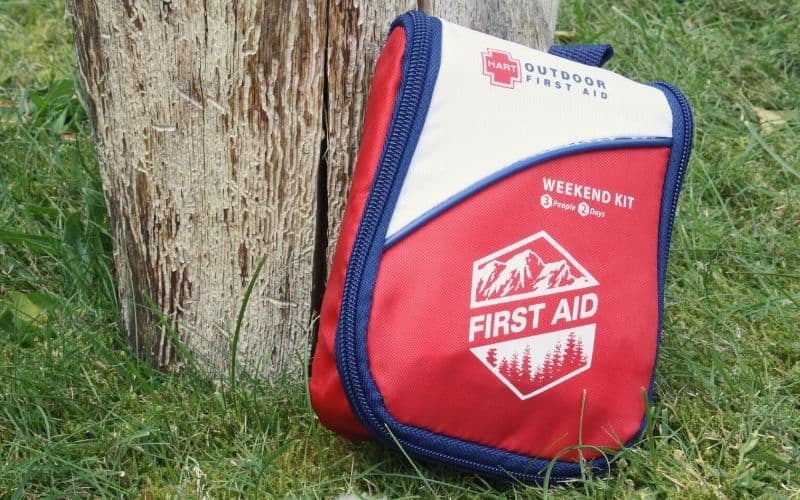
Thirdly, make sure the case containing your supplies is trail-worthy. This means it is both waterproof (or at least water-resistant) and robust enough not to spring holes and let your supplies get wet and/or dirty.
Contents
Unsure what items a backcountry med kit should contain? Let’s take a look at some of the items that should be considered essential and optional.
Essential First Aid Kit Items
When choosing a kit then we would recommend at a minimum the first aid kit includes the following basic items.
- Waterproof medical tape
- Bandages that differ in size
- Butterfly bandages (Wound closure strips)
- Gauze
- Antiseptic wipes (Alcohol prep pads)
- Anti-inflammatory medication such as Ibuprofen
- Anti-diarrhea medication, antacids, and laxatives
- Eye drops
- Electrolyte tablets to stay hydrated
- Tweezers
- Safety pins
- Splints
- Sterile pads
- Antihistamine medication such as Benadryl
- Antibacterial ointment
Optional Items
For longer trips or if you have specialised needs then consider checking for the following.
- Liquid bandages
- Commonly used medications like Aspirin
- Aloe Vera
- Rehydration salts
- Calamine lotion
- Moleskin
- EpiPen (just in case)
- Needle and thread
- Trauma shears
- First Aid Manual
For a more complete list check out our spreadsheet of suggested items below or our guide to creating your own first aid kit, which can be found here.
Types Of Trips To Prepare For
When choosing a backpacking or hiking first aid kit, it’s important to consider how long you will be out on the trail.
For day hikes alone or with one or two partners, we recommend a lightweight, basic kit like the HART Outdoor Day Hike or Surviveware kit.
For multi-day hikes, you’ll need a larger backpacking kit like the Adventure Medical Kits Mountain Backpacker or the Adventure Medical Kits Ultralight Watertight 7. For a larger group, the First Aid Only Outdoor, Be Smart Get Prepared 326-Piece, or Adventure Medical Kits Adventure 2.0 are better options.
And for long-term, group car camping or hiking trips from a basecamp, we recommend choosing between the My Medic MyFak and Ready America 72-Hour.
It’s also wise to do a little research into where you’ll be hiking so you can customize your kit. Certain areas, for example, may be rife with poison oak, poison ivy, or mosquitos, so packing cortisone cream and antihistamines would be recommended for these trips.
On backpacking trips, you’ll want to be prepared for any eventuality by bringing a full complement of supplies. On day hikes on well-maintained trails close to civilization, you can get away with carrying a smaller number of each essential item.
No matter which of the first aid kits you choose, we recommend taking an outdoor first aid or wilderness medicine (aka ‘wilderness first aid’) course that provides basic medical training in outdoor contexts. While most of the kits on our list come with basic instructions, these cannot replace medical training.
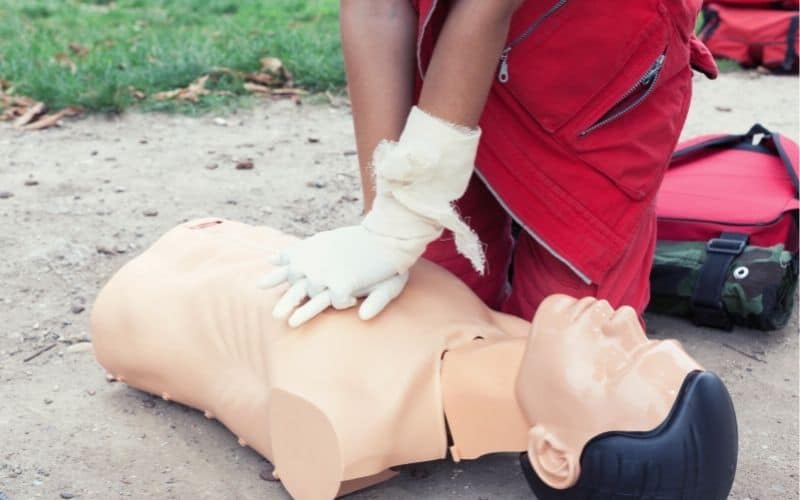
On top of the basic supplies provided, remember to pack any personal medications and use our spreadsheet to identify and add any items that aren’t included.
Size & Weight
The importance of size and weight of your wilderness first aid kit will largely depend on the type and duration of the outdoors activity you are participating in.
For hiking and backpacking, consider an ultralight kit to save weight and space in your pack. Just make sure you don’t skimp on the basic stuff to save weight.
For car campers, the weight and packed size is less of an issue.
What are Common Backpacking and Hiking Ailments and Injuries?
To find the ideal first aid kit for your next hiking, camping, or backpacking trip, it’s advised to know a few things about injuries and ailments that might occur on the trail and the supplies you’ll need to treat them.
Here are a few of the most common medical issues you might have to treat:
- Blisters – Blisters are one of the most common injuries sustained by hikers. They occur as a result of friction between your skin and the fabric of your socks, boots, or shoes. The best way to treat a blister is with a moleskin and standard adhesive bandage, though you’ll also need some antiseptic cream to avoid infection if the blister bursts.
- Sunburn – For any hiker, spending hour upon hour exposed to the sun makes sunburn an inevitability without the right protection. Make sure you carry plenty of high-factor sun cream with you on any hike and pack a tube of aloe to soothe the skin after sunset.
- Cuts & Scrapes – These are likely to occur as a result of falls and trips, or when you hike through bushes and rocky areas of the trail. In most cases, these can be treated with an antiseptic wipe, gauze, and adhesive bandage
- Itching – This can be caused by several things, such as chafing skin (how to prevent chafing), bug bites, or an allergic reaction. Calamine lotion can help soothe any itch, but the best way to prepare for an allergic reaction is to learn how to identify the different types of allergy-inducing flora and steer well clear of them.
- Muscle Cramps – If you are not used to walking long distances for days at a time, your body may cramp up along the trail, especially if you don’t take the time to stretch. Cramps also often occur as a result of dehydration, so be sure to pack plenty of water and some oral rehydration salts if out in hot temperatures.
- Twisted Ankles – Even on well-maintained trails, there are sure to be plenty of rocks and exposed roots that could cause you to twist or sprain your ankle. If this happens, you should wrap the ankle in an elastic bandage, aka an “ACE wrap.”

Best Hiking & Backpacking First Aid Kits: The Verdict
For backpackers or day hikers in small groups, our favorite is the Adventure Medical Kits Ultralight Watertight 7. The AMK 7 is lightweight, waterproof, and well-stocked with everything you need to treat the most common trail injuries and medical issues.
For day hikers, our top two picks are the I Go and HART Health Outdoor kits. Both of these kits are cheap but include ample supplies for solo hikers or couples. If you have a larger group, then the Surviveware Small First Aid Kit is a better choice.
For car camping, base camping, or expeditions, we recommend the My Medic MyFak and Be Smart Get Prepared 326-Piece. The former is the preferred option for large groups on more serious adventures while the latter is a great option for family camping trips.
Always remember that having a first aid kit is not enough in an emergency situation, you will need to take first aid training to help with treating wounds or more serious injuries.
So, how did you like our post? If you have any questions or comments, please reach out in the comments box below. And please feel free to share this post with your friends!
